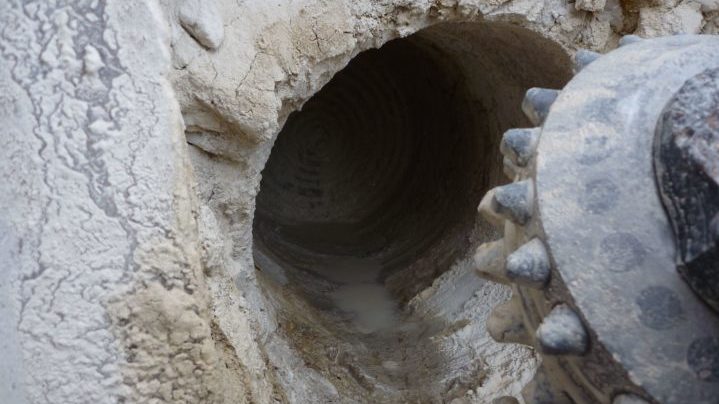Trying to research and compare various methods of trenchless installation can raise more questions than it answers.
What’s the difference between thrust boring and bed boring? Which trenchless techniques use guidance systems? And how big of a margin of error can I expect with each method?
We’ll address each of these questions and more in a comparison of some of the most common trenchless methods in use today.
Two categories of techniques
A comparison of different trenchless methods starts with a distinction between two technology categories: shaft-launched and surface-launched.
Shaft-launched approaches call for a large rectangular pit to be dug on each end of the installation area to accommodate machinery and piping. Drilling is then performed from the entry pit through to the exit pit, the casing and pipes are installed, and the pits are refilled.
Examples of shaft-launched methods include microtunnelling, thrust boring and bed boring.
Surface-launched methods drill straight down from the surface at an angle, levelling out to grade once the required depth is achieved. While the machinery and tooling used for shaft-launched technologies is fundamentally rigid, surface-launched equipment and materials are flexible so that they can navigate bends and flatten out underground.
The primary surface-launched method is horizontal directional drilling (HDD).
Comparison factors
We’ll consider several important elements in our review of trenchless methods:
- Guidance systems
- Ideal applications
- Margin of error
Microtunnelling
Microtunnelling is a shaft-launched method that utilises machines equipped with precision guidance systems and live monitoring. These allow the operator to correct the drill head in real time.
Microtunnelling is ideal when high accuracy is essential. According to Stuart Harrison, Managing Director of Edge Underground, a microtunnelling crew would expect to commonly achieve +/-10mm accuracy over lines of 120m in length, and be at no point more than 10mm out.
“Should you require an installation +/-25mm in accuracy, then really you have no choice but to choose microtunnelling,” Mr Harrison said.
Thrust boring
Also known as auger boring, thrust boring is a very traditional shaft-launched method that involves using brute force and rotation through the auger to push a large closed-end pipe through the earth. Its traditionally unguided nature means that soil heaving or hitting an obstruction are real risks to factor in.
Machinery used for thrust boring generally has a manufacturer accuracy of one per cent. At a typical distance of three metres, the margin of error is thus +/-30mm over 30 metres or +/-1m over 100 metres. Steered thrust boring systems are emerging with potential for greater accuracy, but so far they’ve achieved mixed results.
It is worth noting that there has been a number of safety concerns raised over the use of this method due to the high torque and active augers. As it typically requires the use of a steel casing when a jacking pipe is being used, the costs of installation can also be high.
Bed boring
Bed boring uses hydraulics and rigid drilling rods to drill short bores under surfaces such as roads, walkways and driveways. The equipment is comparatively compact, so it is preferred in situations where access may be an issue.
Like thrust boring, bed boring is shaft-launched and traditionally unguided. Several variables determine accuracy, including the fine-tuning of the setup, consistency of the ground, and the operator’s drilling skill.
Bed boring can be used effectively for short horizontal bores of 25m or less.
Horizontal directional drilling (HDD)
By far the most popular surface-launched method, HDD bores diagonally down and then straightens out to horizontal. The layback area — that is, the extra space required for the diagonal bore to reach the required depth before it levels out — added to the fact that a continuous line of pipe must be used means HDD installations often have a substantial worksite footprint.
HDD rigs operate in conjunction with several systems that assist accuracy. The most common is a walk-over system, which shows the depth, the pitch (angle) and the steer direction. Manufacturers of these guidance systems state an accuracy of five to ten per cent, though three to four per cent can be achieved depending on the ground and operator. A typical three metre deep HDD installation therefore yields a +/-150-300mm margin of error, dropping to +/-100mm in favorable conditions.
A crucial consideration for HDD operators is any underground infrastructure that might be in the way.
“One of the downfalls of HDD when it comes to existing infrastructure is that there needs to be an exit point on the receival end, meaning care needs to be taken in pre-planning to establish a suitable point of exit,” Mr Harrison said.
“HDD also requires excavation to the correct installation depth in the lead-in, as well as on the receival end when installing continuous pipe, meaning there’s additional chances for existing infrastructure to be damaged.”
Conclusion
Differences in shaft-launched versus surface-launched installations can be balanced by the steering system used, ground conditions, guidance system and the operator’s competency.
Ultimately however the decision of which method to use will be the result of a thorough analysis of the project’s specifications, including budget, accuracy needed, space available, and existing underground infrastructure.
Wherever you are in Australia, contact Edge Underground on 1300 522 533 (JACKED) to discuss your microtunnelling job.

